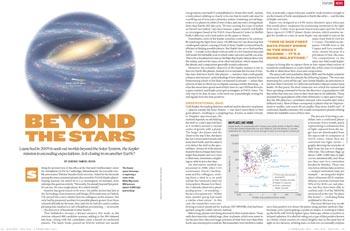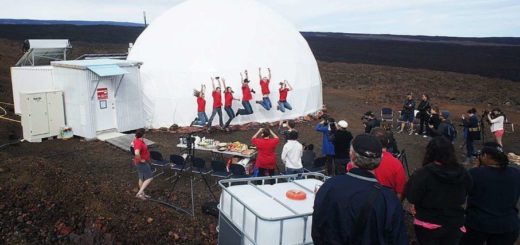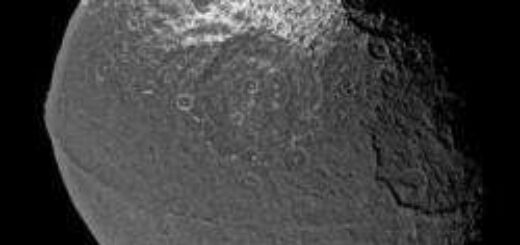Beyond the stars

Sitting for an interview in his office at the Harvard-Smithsonian Center for Astrophysics (CFA) in Cambridge, Massachusetts, the normally voluble astronomer Dimitar Sasselov looks nervous. Asked for his favourite among the many potential planets discovered by NASA’s Kepler planet-finding mission, for which he is a co-investigator, he hesitates, then sidesteps the question entirely. “Personally, I’m already beyond that point. It’s not one. It’s not a single planet. It’s a whole family.”
Sasselov has good reason to be wary: his public lecture last July at the Technology, Entertainment and Design 2010 conference in Oxford, UK, earned him a stern rebuke from his colleagues on the mission. Not only had he presented numbers for possible planets greater than those released officially by the team, they said, but he had also used a careless phrasing that resulted in a raft of headlines proclaiming — incorrectly — the discovery of hundreds of other Earths.
That hullabaloo became a distant memory this week, as the mission released 400 candidate systems, adding to the 306 released last June. Along with the candidates came a bunch of confirmed planets. The latest finds, posted on NASA’s website last month (see http://go.nature.com/aejd15) and published in Nature this week1, include a rocky planet orbiting so closely to its star that its starlit side must be a seething sea of lava; and a planetary system containing several large, rocky or icy planets in orbits of tens of days, just one order of magnitude faster than Earth’s 365-day cycle. “It’s very exciting. It’s a type of system we haven’t seen before,” says Jack Lissauer, a space scientist and Kepler co-investigator based at the NASA Ames Research Center in Moffett Field, California, and a lead author on the paper in Nature.
Nonetheless, most of the Kepler scientists continue to be cautious. By watching the light from some 150,000 stars for the dimming that could signal a planet crossing in front of them, Kepler is extraordinarily efficient at finding possible planets. But Kepler has yet to find another Earth — a small, rocky planet with an orbit of a few hundred days and well inside the habitable zone in which water can exist and life can arise. That is for a fundamental reason; the blips that Kepler detects show only the radius, and not the mass, of an observed planet, which means that the density and composition generally remain unknown.
Moreover, the scientific objective of the Kepler mission is not to discover Earth-like planets. Instead, it is to estimate the fraction of Sun-like stars that have Earth-like planets — statistics that could greatly enhance astronomers’ understanding of how planetary systems form. Determining which of the blips correspond to planets — rather than systems of stars in which one is eclipsed, causing a similar dimming — is what the researchers spend most of their time on, says William Borucki, a space scientist and Kepler principal investigator at NASA Ames. The only way to do that, he says, is the hard way: painstakingly sorting the real signals from the false positives.
Observational bias
The Kepler space telescope is exploring a sliver of the Milky Way some 900 parsecs (about 3,000 light years) deep.
Until Kepler, the leading detection method used to discover exoplanets — planets outside the Solar System — was much more likely to find giant planets, resulting in a sampling bias. Known as radial velocity or Doppler spectroscopy, the method depends on identifying the shift in a star’s spectral lines as it wobbles around a mutual centre of gravity with a planet. The larger the planet and the closer to the star it lies, the faster the star’s movement towards and away from Earth, and the easier it is to detect the shift in the spectral lines. Almost all of the planets found by this technique have been larger than Jupiter and very close to their stars, sometimes completing an orbit in just a few days.
An alternative method was presented in 2000, when CFA astronomer David Charbonneau and his colleagues, working from a shed in a car park outside the National Center for Atmospheric Research in Boulder, Colorado, observed a planet passing across — or transiting — the face of its parent star2. Within days, another group had made a similar observation3. In this case, the researchers were confirming a transit predicted for a planet, HD 209458b, that had been spotted using the radial-velocity method.
Before long, planets were being detected by their transits alone. Those early detections also yielded large, close-in planets, which were easier to see because they obscured larger portions of their host stars than their Earth-size counterparts would do. But researchers were thrilled to realize that, in principle, a space telescope could be made sensitive enough to see the transits of Earth-sized planets in Earth-like orbits — and the idea of Kepler was born.
“This is our first data point down in the rocky regime — it’s a huge milestone.”
Kepler was designed as a 0.95-metre-diameter space telescope that would detect exoplanets by monitoring variations in the light from stars. Unlike most ground-based telescopes and the French Space Agency’s COROT planet-finder mission, which monitor targets for months at a time at most, Kepler was intended to stare at the same, fixed field of view for 3–4 years. This field encompasses 150,000 stars in the Cygnus and Lyra constellations, chosen because of a prevalence of Sun-like stars. The commitment to the same star field made Kepler unique in being able to capture three or four repeat observations of transits by small planets in yearly, Earth-like orbits, even if it wouldn’t be able to determine their mass and composition.
The spacecraft was launched in March 2009, and the Kepler scientists announced their first few planets the following January. “We were just skimming the cream off the top,” says Natalie Batalha, an astronomer at San Jose State University in California and Kepler’s deputy science team leader. At that point, the short timescale over which the mission had been operating continued to favour the discovery of giant planets with fast orbits that were too close to their host stars to be habitable. These included five giant planets with orbits of between 3.2 days and 4.9 days4. But the 306 planetary candidates released a few months later told a different story. Most of these correspond to planets that are Neptune-sized or smaller, and nearly 40 are smaller than twice Earth’s size5. If confirmed, Batalha estimates, five would correspond to planets orbiting within the habitable zones of their stars.
Click for larger image
The process of turning a candidate into a confirmed planet is tortuous. Every month, pixels representing a continuous flux of light captured from the target stars are downloaded from the spacecraft to computers at NASA Ames, where they are converted into light curves — graphs showing the intensity of light from the star as it changes with time. The software flags up about 2,000–3,000 dips in light curves automatically, and these are then sent to a committee headed by Batalha. Those not rejected as obvious false positives — owing to instrument noise, for example — are assigned a Kepler object of interest (KOI) number. Mission scientists estimate that 50% of the KOIs are real planets, but they have been able to confirm only 15 of the 306 KOIs announced so far (see ‘No place like home’) — including those published in this issue.
The most obvious way to rule out a false positive is to detect the planet using another method. Charbonneau, now a participating scientist on Kepler, is working to follow up the KOIs with NASA’s Spitzer Space Telescope, which is sensitive to infrared radiation. It is ideal for ruling out a type of false positive known as a blend, which consists of a much brighter star in the same line of sight as two dimmer, orbiting stars, so that one occasionally eclipses the other. To Kepler, a blend can look like the transit of a Jupiter-sized planet, says Charbonneau — but not to Spitzer, because the three stars will have different proportions of their light in the infrared and visible wavelengths.
Kepler data alone can confirm a candidate when it is part of a system of several planets. Last year, for example, researchers found a planetary system with a pair of planets transiting the same star, at almost regular intervals. “We started to lavish more individual attention on the system once we saw the transits were varying,” says Matthew Holman, an astrophysicist at the CFA and a member of the Kepler team. It was a sign that the planets were real: planets can vary by as much as several minutes per orbit if they are interacting gravitationally with one another. In a rapid orbit, this is the equivalent of Earth’s revolution around the Sun changing by a few hours each year. The new planets, dubbed Kepler-9b and -9c, had radii about 0.8 times the size of Jupiter’s, and orbits of 19 days and 39 days, respectively6. By modelling the gravitational interactions of the planets, the team calculated that their probable masses are similar to that of Saturn. Knowing the mass and radius of each planet helped the astronomers to estimate that the composition of the planets was hydrogen- and helium-rich, making them very much like the gas giants Saturn and Jupiter.
Kepler-9 was the first system in which several planets were found to transit the same star. The paper on page 53 (ref. 1) announces a second, Kepler-11, in which as many as six planets transit, with orbital periods of 10, 13, 22, 31, 46 and 118 days, and masses between 2.3 and more than 300 times that of Earth. Although the outer four are gas giants, the inner two could be ice giants like Neptune. Or they could be super-Earths — planets several times larger than Earth but consisting of a mixture of rock and gas. The team was surprised to see as many as six planets transiting in the same system, says Lissauer, and further astounded to find the inner planets so densely packed that, were they any more so, their orbits would not be stable. “It’s an amazing system,” he says.
Kepler’s full field of view, which encompasses 100 square degrees of sky and 150,000 stars.
Kepler’s full field of view, which encompasses 100 square degrees of sky and 150,000 stars.NASA/AMES/JPL-CALTECH
Subtle effects
Kepler-11b–g come hot on the heels of the January announcement of Kepler-10b, a dense planet circling a Sun-like star in a 0.84-day orbit. In this case, there were no observable transit-timing variations, but because of the closeness to the star, the researchers were able to confirm the planet using ground-based radial-velocity observations that also showed the planet’s mass. At 4.6 times Earth’s mass and only 1.4 times its radius, the planet is dense enough to be unambiguously rocky — although its closeness to the star means that one side will be constantly molten rock. After careful studies of the host star and analyses of a year’s worth of data, the Kepler team was able to pick out not only the dimming due to the transit, but also the cycle of brightening and dimming as the orbiting planet alternately showed its day and night sides towards Earth. “It’s phenomenal” that such a subtle effect was detectable, says Batalha. It also shows what unexpected insights can be gleaned from Kepler’s observations. “This is our first data point down in the rocky regime,” says Batalha, “it’s a huge milestone.”
The Kepler mission has detected other planets for which the mass cannot be determined. One example is Kepler-9d, a super-Earth found in the same system as Kepler-9b and -9c. Computer simulations by Guillermo Torres, an astronomer at the CFA, and his colleagues showed that eclipsing stars could not produce as good a fit to the observed light curve as the match produced by a super-Earth planet passing in front of the Kepler-9 star. That, says the team in a paper in The Astrophysical Journal7, is the first validation of a planet using a general method that could be applied to any of the Kepler candidates, even those that don’t show transit-timing variations and are too far from the star to be studied using the radial-velocity method. “The probability of a planet is higher than the probability of a false positive,” says Torres, “there is a statistical argument.” The method was used again to validate the sixth of the Kepler-11 candidates, Kepler-11g, a gas giant with an orbit of 118 days, far enough from the rest of the cohort that any transit-timing variations are too subtle to have been observed.
The Kepler legacy
Because of the time needed for repeat observations of planets in Earth-length orbits, it will be years before the Kepler researchers can establish the frequency of planets in the cosmos. But that hasn’t prevented other scientists from making preliminary estimates. In 2010, for example, a group led by Andrew Howard, an astronomer at the University of California, Berkeley, took the size distribution of planets found by the radial-velocity method and, by extrapolating to lower masses, predicted that Kepler will find that roughly 22% of stars are orbited by Earth-size planets8.
Borucki is sceptical. “They extrapolated, which is not a mortal sin but it’s close,” he says. But Lissauer is more sanguine. Ultimately, he says, results from the radial-velocity method can be combined with results from the transit method to produce a measured frequency of planets at different sizes, masses and compositions — from rocky Earths to gaseous Jupiters. And those data, in turn, will be invaluable for helping astronomers to understand the origin and evolution of planetary systems throughout our Galaxy. “There’s a whole load of good science in there,” says Lissauer.
The promise, says Batalha, is that Kepler will deliver a massive roster of objects for future generations to follow up on. “Kepler will leave this legacy. People are going to use these data for decades,” she says.



 Creators of mankind
Creators of mankind Description of “Tall white aliens”
Description of “Tall white aliens” Where they came from?
Where they came from? About hostile civilizations
About hostile civilizations The war for the Earth
The war for the Earth “Tall white aliens” about eternal life
“Tall white aliens” about eternal life Video: “Nordic aliens”
Video: “Nordic aliens” Aliens
Aliens Alien encounters
Alien encounters The aliens base
The aliens base UFO
UFO Technology UFO
Technology UFO Underground civilization
Underground civilization Ancient alien artifacts
Ancient alien artifacts Military and UFO
Military and UFO Mysteries and hypotheses
Mysteries and hypotheses Scientific facts
Scientific facts


















